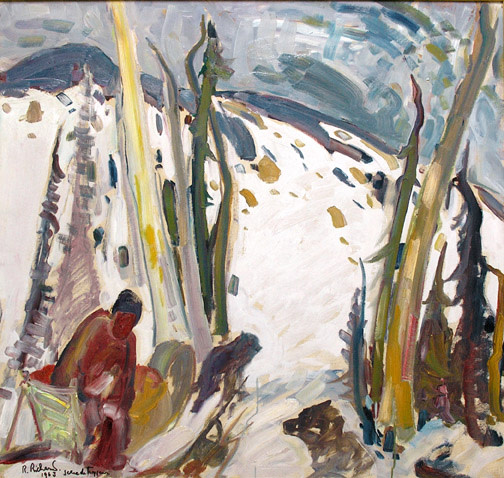René Richard Paints "Trapper with Dogsled"

René Richard, Trappeur with Dogsled, oil on masonite.
Provenance: Private collection, Toronto.
Highlight
Recent purchases of a group of excellent paintings by René Richard (1895 - 1982), inspired this reflection of his stature as an important and genuine Canadian artist. He has long been considered of iconic stature in Quebec, the province where he made his home almost 30 years after he had arrived here in Canada from Switzerland with his father and mother.
Manitoba born author Gabrielle Roy celebrated René Richard by styling her hero Pierre Cadoral in La Montagne Secrète after him. However, the facts of his first few decades in Canada suggest to me that his recognition should be equally prominent in Western Canada, an important region fueling today’s art market and with a dearth of historical artists whose work celebrates the magnificence of the Western landscape of the generation of René Richard.
Rarely titled by the artist, these woodsmen-trapper subjects are often of Western subject matter and are significant ethnographic paintings executed by a fine Canadian artist who himself was a former trapper and woodsman. In 1909, the Richards came to Montreal from Switzerland, but after two years for reasons unknown, chose to relocate to Cold Lake, Alberta, which back then was both remote and isolated. Richard’s father, Paul-Jean Richard, operated what I think today would be termed a trading post, or general store selling supplies to natives and receiving furs as payment. A fur trader may be an equally appropriate description of what Richard’s father did.
René Richard, in his diaries, refers to another adolescent named Dick with whom he first went exploring the land at age 16. His interest stimulated, he embarked on a life of a woodsman and trapper, a career that took him on expeditions to Northeastern Alberta, Saskatchewan, and Manitoba and on to James Bay. In Montreal's La Presse of January 26, 1963 René Richard is quoted as saying: ''I will never forget this wild country, of northern Alberta. I frequented this country, my God. Townbee, the west coast, up until Yukon, the Belle River, the Porc-épic sent down just to Port Yukon. It was quite a trail! At Dawson we came through the Pacific because the Mackenzie was covered in ice! What was there to paint? The forest, at 78 degrees, there were still some nice pine trees. Certainly in the areas that were covered in sun, the rest in desert…already I loved high mountains...''
It was only several years later when he went East, that he discovered the landscapes of Ungava, the Saguenay River, the Quebec North Shore and, of course, Charlevoix where he settled down in Baie St. Paul. It was during Richard’s expeditions prior to and after his three years of art studies in Europe from 1927 that Richard drew sketches of the experiences of the Canadian trapper / woodsman, of abandoned camps, the woodman’s canoe, the burning campfire, the trapper's sled dogs, and the occasional glimpses of the camaraderie of a meeting of another trapper.
While in Paris, it is said that fellow Canadian Clarence Gagnon was most encouraging of his talent and his interest. The European interlude honed Richard's draughtsmanship ability. Drawings described after his return are of especially great quality and are confidently executed. Of these years overseas he said; "It was an apprenticeship. I was going to return to my childhood dream, America! I was happy to return. I was once again a woodsman. I had my own canoe. It was complicated particularly the material. Winnipeg was a more familiar area where I could stock up on paint brushes, colors and the rest. I had a friend who soon became postman of the Mackenzie. He would look for mining concessions. He asked me to help. For my salary he would get me art supplies in a town called Flin Flon, far North. He held his word and came with supplies filling the entire canoe!'' (La Presse Montreal Jan 26 1963 interview with C Jasmin.)
For all intents and purpose it is from the time René Richard settled in Baie St. Paul, buying the former home of Clarence Gagnon, that he paints in oils, regularly using as his resource the fine drawings of his trapping days. Hence, these themes are commonly of Alberta, Saskatchewan and Manitoba content describing his life and experiences throughout the 1930s in areas including the Churchill River, the Fort McMurray and Jasper regions. Since René Richard rarely titled his paintings, and when he did he inscribed them with generic titles like ''Encampement indienne" (Indian Encampment), upheld was the popular misconception that the content is exclusively Quebec.
Of course his legacy does includes a strong and extensive body of work Richard executed in the Charlevoix area, which inspired him on his regular explorations into the local countryside, a kind of work which has influenced a number of artists painting in the picturesque Charlevoix county. Of Charlevoix he expressed the following; "I settled down in Baie St-Paul in 1940…Clarence Gagnon, who came to visit had lived there 14 years! And myself? I would never leave this area….the Côte Nord, it’s a beautiful country. We are surrounded by forests. We leave by the Gouffre river. There are marvelous sights…The Laurentide Park is not too far away, up high, the Saguenay, it’s at the side, the river, the Chantier roads with wide open forest…Now, I always work but more calmly. In the West, it was different, I had already sketched a hunter who was skinning a fox! One had to have a solid heart. I always work, yes. You see, a painter's work, it needs to be pursued !" ( La Presse Montreal Jan 26 1963 interview with C Jasmin.)
And of his art he continued: "My art? I look to communicate my great love of nature, of landscapes. That's all. Nature is important for every man whether or not he is a surrealist. Sometimes I do abstract. It's interesting. It needs to be organized, reasoned. It needs intelligence, even from a primitive painter." (La Presse Montreal, Jan 26 1963 interview with C. Jasmin.)
Hazarding to guess why René Richard 's recognition factor is relatively low outside of Quebec, I speculate that it is in part because, like Marc A. Fortin , Richard's distribution was only regional. That is to say, even in the late 1960s, as had been our custom, when we wanted to purchase Richard paintings we had to drive to Baie St Paul some 220 miles from Montreal to visit René Richard where reluctantly he would sometimes allow us to buy only 4 or 5 works, those large 41" x 48" compositions retailing for only $1,500. A trip like this for an art dealing colleague from as close as Toronto, for instance, would not have been a profitable one.
Consequently, virtually all of Richard's oeuvre has historically been owned here in Quebec sold by the artist himself (his wife Blanche) and by Quebec based art galleries like the Klinkhoff Gallery, Kastel, Morency here in Montreal, René Bergeron in Chicoutimi, and Zannetin in Quebec City to name a selection. Since collectors cannot ask for works by artists whose paintings they have rarely seen and since our colleagues were unlikely to recommend to their clients paintings for which they had little or no supply, art collectors outside of the Province of Quebec were rarely encouraged to pursue the acquisition of a René Richard.
Going forward, however, as prices rise the participation of art dealers becomes more interesting, that is, profitable, and quality paintings travel more as demand increases. Again, look at the evolution of the Fortin market where it took 70 long years for the best of his work to achieve a price of $100,000 and 5 short ones to rise to $500,000! All the aforemetioned is intended to mean is that, in my opinion, fine René Richard paintings are Canadian works of art of quality, relevant to a Canada-wide audience, of far greater historical importance than they are given credit, and relative to so many works of art collectors purchase, they are rather inexpensive. As you should expect, I encourage you to look at the Richards at www.klinkhoff.ca and to contact Eric, Jonathan or myself to check availability of other fine René Richards.




